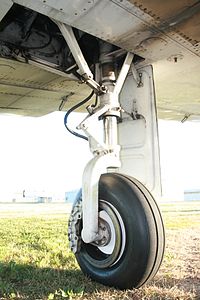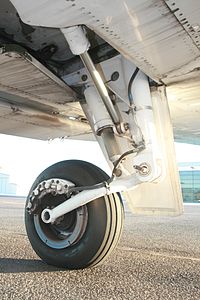Oleo strut
Anoleo strutis apneumaticair–oil hydraulicshock absorberused on thelanding gearof most largeaircraftand many smaller ones.[1]This design cushions the impacts of landing and damps out vertical oscillations.
It is undesirable for an airplane to bounce on landing as it could lead to a loss of control,[2]and the landing gear should not add to this tendency. A steelcoil springstores impact energy from landing and then releases it, while an oleo strut instead absorbs this energy, reducing bounce.[3][4]As the strut compresses, thespring rateincreases dramatically because the air is being compressed. Theviscosityof the oil damps the rebound movement.[5][6]
History[edit]
The original design for the oleo-pneumatic shock-absorbing strut waspatentedby British manufacturing conglomerateVickers Armstrongduring 1915.[7]It had been derived from the recuperative gear design of theVickers gun,controllingrecoilby forcing oil through precisely sized orifices. Vickers' oleo strut was first applied to an aeroplane by the French aircraft companyBreguet Aviation.[7]
The design proved to be viable and was extensively adopted across the aviation industry for fixed undercarriages, becoming simply referred to as an "Oleo unit" or undercarriage leg.[7]Vickers' initial design had placed air above the oil, an arrangement that did not pose any problem until the introduction ofretractable landing gearduring the mid-1930s. The engineer, Peter Thornhill, devised a novel undercarriage strut that used a free-floating piston, not only being a lighter arrangement but enabling the whole strut to be inverted and to work while at an angle, eliminating the weakness of using an oil and air mixture.[7][8]Oleo-pneumatic technology was subsequently reused by the manufacturer to produce several other products, includinghydraulic railway buffersand industrial shock absorbers.[9]

During 1926, the Cleveland Pneumatic Tool Company designed and introduced an oleo strut, one of the first to be purpose-designed for use on airplanes. The company subsequently marketed the product as anAerolstrut, which had entered widespread use within theUnited Stateswithin the space of a decade.[10][11][12][13]By 1931, innovations in the field were being made in theUnited Kingdom,France,and North America.[14]The oleo strut became commonly used for aviation purposes around the world.[3]By the twenty-first century, a wide range of different shock-absorbing struts were in use, but typically employ common principles, despite considerable variations in size, weight, and other characteristics.[15][16]
Refinements continued to be made to the technology behind the oleo strut. During 1954,hydropneumatic suspensionwas introduced, which uses the same principle of a gas that compresses (nitrogen) and a fluid that does not; in this use, an engine-drivenpumpis used to pressurize thehydraulic fluid.[citation needed]Another such example was a USpatentfiled by Jarry Hydraulics during 1958.[17]During the 1960s, the BritishMinistry of Technologysponsored research into theoretical studies into improved oleo-damping technology.[18]In 2012, it was proposed that the vibration-damping qualities of the oleo strut could be enhanced by using semi-active control to adjust fluid viscosity.[19]The use of oleo struts for electric-poweredautomatic guided vehicleshas also been evaluated.[20]
According to Engineering360, by 2019, the oleo-pneumatic strut had become the most common type of shock absorber in use on modern aircraft.[4]The oleo strut has seen much use on the largest cargo airplanes in the world, such as theAntonov An-124 Ruslan;it reportedly provides for a rough-field landing capacity while carrying payloads of up to 150 tons. This design also cushions theairframefrom the impacts oftaxiing,resulting in greater levels of comfort for passengers and crew.[21]
In non-aircraft use, the Quadro range ofmotor scootersuse the oleo strut, which is claimed to give favourable low speed lean characteristics.[22]
Operation[edit]

An oleo strut consists of an inner metal tube orpiston,which is attached to the wheel axle, and which moves up and down in an outer (or upper) metal tube, or cylinder, that is attached to theairframe.The cavity within the strut and piston is filled with gas (usually nitrogen, sometimes air—especially onlight aircraft) andoil(usually hydraulic fluid), and is divided into two chambers that are connected by a small orifice of a precise, calculated size.[4][23]
When the aircraft is stationary on the ground, its weight is supported by the compressed gas in the cylinder.[1]During landing, or when the aircraft taxis over bumps, the piston slides up and down.[4]This movement compresses the gas, which acts as a spring, and forces oil through the orifice, which acts as a damper. A tapered rod is used on some designs to change the size of the orifice as the piston moves, providing greater resistance as compression of the strut increases. Additionally, a check valve is sometimes used to uncover additional orifices so that damping during compression is less than during rebound. Oleo struts absorb and dissipate forces by converting a portion of the accumulated kinetic energy into thermal energy.[4]
Pneumaticsystems like the oleo strut generally have long operating lives, and the construction is not unusually complex for maintenance purposes.[24]Nitrogen is usually used as the gas instead of air, since it is less likely to causecorrosion.The various parts of the strut are sealed withO-ringsor similar elastomeric seals, and a scraper ring is used to keep dust and grit adhering to the piston from entering the strut.[21]
See also[edit]
- FedEx Express Flight 80– bounce during landing leading to crash
References[edit]
- ^abVan Sickle, Neil D.; Welch, John F; Bjork, Lewis; Bjork, Linda (1999).Van Sickle's modern airmanship.McGraw Hill Professional. p. 125.ISBN978-0-07-069633-4.Retrieved12 March2011.
- ^Welcome Guest Login Here."Activities, Courses, Seminars & Webinars - ALC_Content - FAA - FAASTeam".FAASafety.gov.Retrieved26 June2016.
- ^ab"Airframe Structural Design"(PDF).club66pro. pp. 456–460.Retrieved17 June2020.
- ^abcdeOlson, Eric (7 November 2019)."How do oleo-pneumatic shock struts work?".insights.globalspec.
- ^"Flight Training Magazine - AOPA".Flighttraining.aopa.org. November 2004.Retrieved26 June2016.
- ^Fri, 07/22/2011 (26 December 2008)."Oleo struts | Welcome to the P28B Web Site".P28b.Retrieved26 June2016.
{{cite web}}:CS1 maint: numeric names: authors list (link) - ^abcd"The Oleo Story".Oleo.co.uk.Retrieved17 June2020.
- ^"A New Oleo‐Pneumatic Strut: An Improved Version of the Undercarriage Strut produced by Vickers (Aviation) Ltd".Aircraft Engineering and Aerospace Technology.7(4): 100–101. 1 April 1935.doi:10.1108/eb029926.ISSN0002-2667.
- ^"History".Oleo.co.uk.Retrieved17 June2020.
- ^Cleveland. The Making of a City, p. 865.
- ^"The Savvy Aviator #31: Know Your Oleo".avweb. 10 May 2006.
- ^American Engineer's Feat Proves Boom to Aviation. Aeronautical World Journal of Commerce, 1930. Vol. 3-4, p. 34.
- ^Absorbing the Shocks. US Air Services, 1931. Vol. 16, p. 48.
- ^Dowty, G. H (May 1931)."Description of Landing Wheels with Oleo Strut".dowtyheritage.org.uk.
- ^"Shock Strut - Aircraft Landing Gear Systems".aircraftsystemstech.Retrieved17 June2020.
- ^"Oleo Strut Basics"(PDF).electricmotorglider. November 2006.
- ^"Patent US2959410: Double stage oleo-pneumatic shock absorber".1958.Retrieved26 June2016.
- ^Hall, H. (1967)."Some Theoretical Studies Concerning Oleo Damping Characteristics"(PDF).Her Majesty's Stationery Office.
- ^Asthana, Chandra B.; Rama B. Bhat (November 2012)."A Novel Design of Landing Gear Oleo Strut Damper using MR Fluid for Aircraft and UAV's".Applied Mechanics and Materials.
- ^Macfarlane, Alexander; Udo Becker; Theo van Niekerk (16 January 2017)."Oleo strut for use on modular electric automatic guided vehicles".2016 Pattern Recognition Association of South Africa and Robotics and Mechatronics International Conference (PRASA-RobMech).IEEE Xplore. pp. 1–8.doi:10.1109/RoboMech.2016.7813186.ISBN978-1-5090-3335-5.S2CID6531759.
- ^abWoodhouse, Mary; Gifford, Scott (1996).How to make your airplane last forever.Tab Books. p. 75.ISBN978-0-07-071704-6.
- ^Radu, Mihnea (5 November 2014)."2015 Quadro 4 Pushes Leaning and Stability to Extremes at EICMA 2014".Retrieved6 July2016.
- ^Twombly, Ian J (5 August 2013)."How it works".Aircraft Owners and Pilots Association.
- ^Garrison, Peter (30 April 2012)."Sherlock and the Sagging Strut".Flying Magazine.Retrieved26 June2016.


